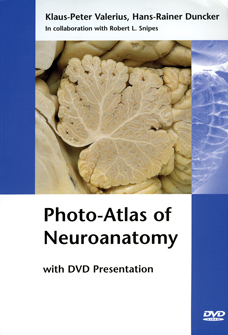
Photo-Atlas of Neuroanatomy with DVD Presentation
(Book/DVD-ROM set)
Klaus-Peter Valerius and Hans-Rainer Duncker
This atlas and accompanying DVD-ROM of the central nervous system is intended as a supplement in neuroanatomy for medical school students. The dissections and specimens can be studied at length and as often as necessary in order to gain an orientation of the complexity of the human brain and to coordinate this with the terminology of the central nervous system. The photographic atlas provides ready access to still material and follows the layout of the film sequences. Because not all visible structures can be named in a single demonstration, the picture atlas supplements with detailed labeling in parallel to the main scenes of the DVD. Special attention is given to the presentation of the clinically important meninges as well as the cranial nerves and the vessels of the inner skull.
Formalin-fixed brains were mainly used, as in most pre-clinical gross anatomy courses. No attempt was made to employ special staining techniques. In order to concentrate on the presentation of the essentials and in an effort to present as precise an orientation as possible, functional explanations have been omitted. Anglicized terminology is used rather than the terminology of the Terminologica anatomica.
The ability to make a reliable diagnosis depends expecially on the knowledge of the structures and the functions of the human body. Profound knowledge of human anatomy is therefore an absolute prerequisite for every medical assignment. Modern diagnostic methods do not relieve the necessity of learning anatomy. Computer tomography and nuclear magnetic resonance allow a view into the human body while the patient is still alive such as one would never have thought possible decades ago. But knowledge gained from such images as well as those available from the most modern equipment supplying 3D pictures can only be interpreted with underlying basic, conventionally gained anatomical knowledge. Detailed anatomical knowledge is especially essential for professionals working in operative fields. All modern equipment improving the precision and security of surgical interventions, for example, the neuronavigation can only be used in combination with interpretation gained with exact knowledge of the anatomy and its content. From the viewpoint of a neurosurgeon, these comments should illustrate to you the necessity for attaining profound knowledge in anatomy for your future medical practice.
